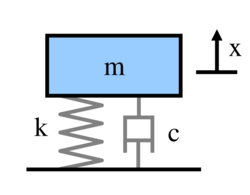Physics:Mass-spring-damper model
The mass-spring-damper model consists of discrete mass nodes distributed throughout an object and interconnected via a network of springs and dampers. This model is well-suited for modelling object with complex material properties such as nonlinearity and viscoelasticity. Packages such as MATLAB may be used to run simulations of such models.[1] As well as engineering simulation, these systems have applications in computer graphics and computer animation.[2]
Derivation (Single Mass)
Deriving the equations of motion for this model is usually done by examining the sum of forces on the mass:
- [math]\displaystyle{ \Sigma F = -kx - c \dot x +F_{external} = m \ddot x }[/math]
By rearranging this equation, we can derive the standard form:
- [math]\displaystyle{ \ddot x + 2 \zeta \omega_n \dot x + \omega_n^2 x = u }[/math] where [math]\displaystyle{ \omega_n=\sqrt\frac{k}{m}; \quad \zeta = \frac{c}{2 m \omega_n}; \quad u=\frac{F_\text{external}}{m} }[/math]
[math]\displaystyle{ \omega_n }[/math] is the undamped natural frequency and [math]\displaystyle{ \zeta }[/math] is the damping ratio. The homogeneous equation for the mass spring system is:
- [math]\displaystyle{ \ddot x + 2 \zeta \omega_n \dot x + \omega_n^2 x = 0 }[/math]
This has the solution:
- [math]\displaystyle{ x = A e^{-\omega_n t \left(\zeta + \sqrt{\zeta^2-1}\right)} + B e^{-\omega_n t \left(\zeta - \sqrt{\zeta^2-1}\right)} }[/math]
If [math]\displaystyle{ \zeta \lt 1 }[/math] then [math]\displaystyle{ \zeta^2-1 }[/math] is negative, meaning the square root will be negative the solution will have an oscillatory component.
See also
- Numerical methods
- Soft body dynamics#Spring/mass models
- Finite element analysis
References
 |


